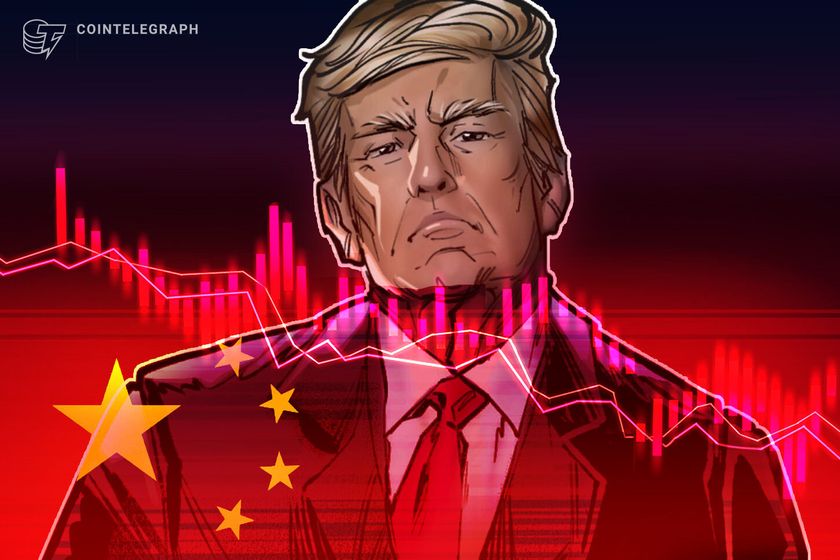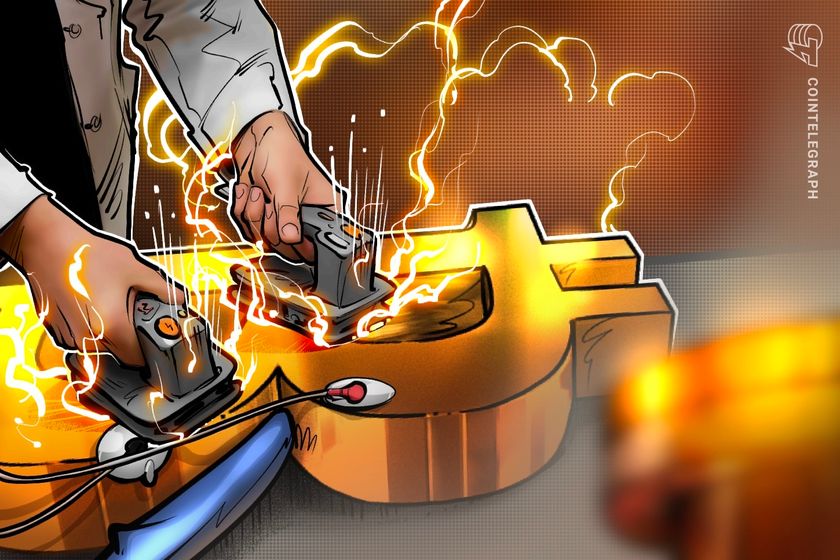Cointelegraph.com
Source:
https://cointelegraph.com
Found 4889 news
-
Cointelegraph.com - 22:56 Oct 11, 2025
 Bitcoin tumbles to $102,000 on Friday amid ‘macro whiplash,’ crypto betting platform Shuffle announces user data breach: Hodler’s Digest US President Donald Trump announced a 100% tariff on China on Friday, sending the price of Bitcoin reeling below $110,000 at the time of writing. Trump said the tariffs were in response to China attempting to place export restrictions on rare earth minerals, which are crucial for creating computer chips. Trump wrote on Truth Social: It has just been learned that China has taken an extraordinarily aggressive position on Trade in sending an extremely hostile letter to the World, stating that they were going to, effective November 1, 2025, impose large-scale Export Controls on virtually every product they make. Read more
Bitcoin tumbles to $102,000 on Friday amid ‘macro whiplash,’ crypto betting platform Shuffle announces user data breach: Hodler’s Digest US President Donald Trump announced a 100% tariff on China on Friday, sending the price of Bitcoin reeling below $110,000 at the time of writing. Trump said the tariffs were in response to China attempting to place export restrictions on rare earth minerals, which are crucial for creating computer chips. Trump wrote on Truth Social: It has just been learned that China has taken an extraordinarily aggressive position on Trade in sending an extremely hostile letter to the World, stating that they were going to, effective November 1, 2025, impose large-scale Export Controls on virtually every product they make. Read more -
Cointelegraph.com - 22:56 Oct 11, 2025
 Bitcoin tumbles to $102,000 on Friday amid ‘macro whiplash,’ crypto betting platform Shuffle announces user data breach: Hodler’s Digest US President Donald Trump announced a 100% tariff on China on Friday, sending the price of Bitcoin reeling below $110,000 at the time of writing. Trump said the tariffs were in response to China attempting to place export restrictions on rare earth minerals, which are crucial for creating computer chips. Trump wrote on Truth Social: It has just been learned that China has taken an extraordinarily aggressive position on Trade in sending an extremely hostile letter to the World, stating that they were going to, effective November 1, 2025, impose large-scale Export Controls on virtually every product they make. Read more
Bitcoin tumbles to $102,000 on Friday amid ‘macro whiplash,’ crypto betting platform Shuffle announces user data breach: Hodler’s Digest US President Donald Trump announced a 100% tariff on China on Friday, sending the price of Bitcoin reeling below $110,000 at the time of writing. Trump said the tariffs were in response to China attempting to place export restrictions on rare earth minerals, which are crucial for creating computer chips. Trump wrote on Truth Social: It has just been learned that China has taken an extraordinarily aggressive position on Trade in sending an extremely hostile letter to the World, stating that they were going to, effective November 1, 2025, impose large-scale Export Controls on virtually every product they make. Read more -
Cointelegraph.com - 22:41 Oct 11, 2025
 Bitcoin’s $16,700 drop on Friday triggered $5B in futures liquidations, exposing a fragile market structure and renewed volatility despite this year’s spot BTC ETF-driven optimism. Key takeaways: Friday’s Bitcoin price crash shows volatility persists in the spot BTC ETF era, with leverage and liquidity stress amplifying losses. Liquidations hit $5 billion as portfolio margin systems failed, highlighting risks of illiquid collateral assets. Read more
Bitcoin’s $16,700 drop on Friday triggered $5B in futures liquidations, exposing a fragile market structure and renewed volatility despite this year’s spot BTC ETF-driven optimism. Key takeaways: Friday’s Bitcoin price crash shows volatility persists in the spot BTC ETF era, with leverage and liquidity stress amplifying losses. Liquidations hit $5 billion as portfolio margin systems failed, highlighting risks of illiquid collateral assets. Read more -
Cointelegraph.com - 21:47 Oct 11, 2025
 The crash was caused by a perfect storm of short-term factors, causing $20 billion in liquidations — the worst 24-hour drain in crypto history. The sudden market crash on Friday, which caused some cryptocurrencies to decline by as much as 95% in under 24 hours, does not signal a long-term bearish outlook or deteriorating fundamentals, according to investment analysts at The Kobeissi Letter. Friday’s market meltdown was triggered by a perfect storm of short-term factors, including “excessive leverage and risk,” and US President Donald Trump’s announcement of 100% tariffs on China, the analysts wrote. The Kobeissi letter cited the market’s heavy long bias, with $16.7 billion in long positions liquidated compared to just $2.5 billion in short positions, a ratio of nearly 7:1. Read more
The crash was caused by a perfect storm of short-term factors, causing $20 billion in liquidations — the worst 24-hour drain in crypto history. The sudden market crash on Friday, which caused some cryptocurrencies to decline by as much as 95% in under 24 hours, does not signal a long-term bearish outlook or deteriorating fundamentals, according to investment analysts at The Kobeissi Letter. Friday’s market meltdown was triggered by a perfect storm of short-term factors, including “excessive leverage and risk,” and US President Donald Trump’s announcement of 100% tariffs on China, the analysts wrote. The Kobeissi letter cited the market’s heavy long bias, with $16.7 billion in long positions liquidated compared to just $2.5 billion in short positions, a ratio of nearly 7:1. Read more -
Cointelegraph.com - 21:09 Oct 11, 2025
 The selling in Bitcoin and altcoin is not over yet, but data suggests that the nature of the CME Bitcoin and equities futures market open on Sunday will determine the direction BTC price takes. Key points: A sharp reduction in aggregate open interest highlights the severity of the $20 billion in leveraged liquidations and highlights traders’ reluctance to re-enter the market. Bitcoin selling and price weakness are likely to extend until CME BTC and equities futures markets open on Sunday evening, US hours. Read more
The selling in Bitcoin and altcoin is not over yet, but data suggests that the nature of the CME Bitcoin and equities futures market open on Sunday will determine the direction BTC price takes. Key points: A sharp reduction in aggregate open interest highlights the severity of the $20 billion in leveraged liquidations and highlights traders’ reluctance to re-enter the market. Bitcoin selling and price weakness are likely to extend until CME BTC and equities futures markets open on Sunday evening, US hours. Read more -
Cointelegraph.com - 19:44 Oct 11, 2025
 Some altcoins lost over 95% of their value during Friday’s crash, which triggered the most severe and rapid liquidations in crypto history. Ether (ETH), the native cryptocurrency of the layer-1 Ethereum blockchain network, is down about 6.7% in the past 24 hours, following Friday’s market crash, showing greater price resilience than many altcoins, which crashed by over 95% in some cases. The market crash sparked by US President Donald Trump’s tariff announcement took the price of ETH down to a low of about $3,510 on Friday, a decline of over 20% in a single day. Price tapped the 200-day exponential moving average (EMA), a dynamic support level, before rebounding to over $3,800. The relative strength index (RSI) is also at 35, nearing oversold conditions, signaling a potential reversal to the upside. Read more
Some altcoins lost over 95% of their value during Friday’s crash, which triggered the most severe and rapid liquidations in crypto history. Ether (ETH), the native cryptocurrency of the layer-1 Ethereum blockchain network, is down about 6.7% in the past 24 hours, following Friday’s market crash, showing greater price resilience than many altcoins, which crashed by over 95% in some cases. The market crash sparked by US President Donald Trump’s tariff announcement took the price of ETH down to a low of about $3,510 on Friday, a decline of over 20% in a single day. Price tapped the 200-day exponential moving average (EMA), a dynamic support level, before rebounding to over $3,800. The relative strength index (RSI) is also at 35, nearing oversold conditions, signaling a potential reversal to the upside. Read more -
Cointelegraph.com - 17:38 Oct 11, 2025
 The provision in the National Defense Authorization Act could create even more economic pain for the crypto mining industry if passed. The US Senate has advanced sweeping AI legislation under the National Defense Authorization Act, compelling chipmakers to serve US customers first before exporting advanced processors abroad. On Thursday, senators passed the Guaranteeing Access and Innovation for National Artificial Intelligence Act of 2026, or GAIN Act, as an amendment to National Defense Authorization Act, requiring AI and high-performance chipmakers to prioritize domestic orders before exporting their products. The GAIN Act also gives Congress the right to deny export licenses for the most high-end AI processors and mandates export licenses for all products containing an “advanced integrated circuit.” “Over the past several years, US firms have faced regular backlogs in purchasing chips. In late 2024, Nvidia’s Blackwell line was booked out roughly 12 months ahead,” according to policy advocacy group “Ameri...
The provision in the National Defense Authorization Act could create even more economic pain for the crypto mining industry if passed. The US Senate has advanced sweeping AI legislation under the National Defense Authorization Act, compelling chipmakers to serve US customers first before exporting advanced processors abroad. On Thursday, senators passed the Guaranteeing Access and Innovation for National Artificial Intelligence Act of 2026, or GAIN Act, as an amendment to National Defense Authorization Act, requiring AI and high-performance chipmakers to prioritize domestic orders before exporting their products. The GAIN Act also gives Congress the right to deny export licenses for the most high-end AI processors and mandates export licenses for all products containing an “advanced integrated circuit.” “Over the past several years, US firms have faced regular backlogs in purchasing chips. In late 2024, Nvidia’s Blackwell line was booked out roughly 12 months ahead,” according to policy advocacy group “Ameri... -
Cointelegraph.com - 17:26 Oct 11, 2025
 After yesterday's multibillion dollar leveraged crypto wipeout, traders are licking their wounds — but those who cannot remember the past are condemned to repeat it. I’m not your mother, your priest, or Gary Gensler. I’m not going to tell you that you shouldn’t use 50x leverage gambling on lower-liquidity altcoins on a centralized crypto exchange, because you are a human adult in the year 2025, and you can gamble whatever the hell you care to gamble. But I do have one word of advice, and you can take it or leave it. Read more
After yesterday's multibillion dollar leveraged crypto wipeout, traders are licking their wounds — but those who cannot remember the past are condemned to repeat it. I’m not your mother, your priest, or Gary Gensler. I’m not going to tell you that you shouldn’t use 50x leverage gambling on lower-liquidity altcoins on a centralized crypto exchange, because you are a human adult in the year 2025, and you can gamble whatever the hell you care to gamble. But I do have one word of advice, and you can take it or leave it. Read more -
Cointelegraph.com - 16:58 Oct 11, 2025
 ZEC recovered all its value lost during Friday's market meltdown and also hit a recent high of $291 before dipping to the $270 level. The price of Zcash (ZEC), a supply-capped, shielded, layer-1 coin dedicated to user privacy, fully recovered following Friday’s market crash, forming a new recent high of about $291 on Saturday before retracing to about $273 at the time of this writing. Zcash plummeted by 45% on Friday, falling from a high of about $273 to $150, following a social media post from United States President Donald Trump announcing 100% tariffs on China, which sent the crypto markets into a meltdown. ZEC is only down about 5.5% from its recent high, making it a standout in this market crash. Many cryptos are still down by double digits from their recent highs, including Ether (ETH), which is down by about 22% from its recent and all-time high of $4,957. Read more
ZEC recovered all its value lost during Friday's market meltdown and also hit a recent high of $291 before dipping to the $270 level. The price of Zcash (ZEC), a supply-capped, shielded, layer-1 coin dedicated to user privacy, fully recovered following Friday’s market crash, forming a new recent high of about $291 on Saturday before retracing to about $273 at the time of this writing. Zcash plummeted by 45% on Friday, falling from a high of about $273 to $150, following a social media post from United States President Donald Trump announcing 100% tariffs on China, which sent the crypto markets into a meltdown. ZEC is only down about 5.5% from its recent high, making it a standout in this market crash. Many cryptos are still down by double digits from their recent highs, including Ether (ETH), which is down by about 22% from its recent and all-time high of $4,957. Read more -
Cointelegraph.com - 13:30 Oct 11, 2025
 AI wearables will harvest our most intimate data while we pretend privacy still exists. Cryptography could enable us to keep our privacy. Opinion by: Evin McMullen, co-founder and CEO of Billions Network and co-founder of Privado ID Population monitoring has evolved over the years. First, it was from other people; later, it was data harvesting. In 2025, wearable technology is the new frontier for broader public surveillance. This isn’t necessarily some dystopia, nor is it comfortable — it is a new paradigm in how we engage with each other and our data. While it’s inevitable that people will need to redefine their expectations around privacy as we enter this new era of surveillance, now is the time to seize the opportunity to shape this new normal before technology sidelines us from active participants to passive subjects. Read more
AI wearables will harvest our most intimate data while we pretend privacy still exists. Cryptography could enable us to keep our privacy. Opinion by: Evin McMullen, co-founder and CEO of Billions Network and co-founder of Privado ID Population monitoring has evolved over the years. First, it was from other people; later, it was data harvesting. In 2025, wearable technology is the new frontier for broader public surveillance. This isn’t necessarily some dystopia, nor is it comfortable — it is a new paradigm in how we engage with each other and our data. While it’s inevitable that people will need to redefine their expectations around privacy as we enter this new era of surveillance, now is the time to seize the opportunity to shape this new normal before technology sidelines us from active participants to passive subjects. Read more -
Cointelegraph.com - 13:15 Oct 11, 2025
 Major policy changes worldwide are shaping how the crypto industry will operate. As crypto adoption increases globally, governments are grappling with the potential impacts on their financial systems and economic stability. This week, several major policy changes have impacted the crypto industry — some that hinder innovation and others that bolster it. In the US, a government shutdown has halted any consideration of crypto-focused exchange-traded funds (ETFs). Federal agencies are operating with minimal staff until Congress reaches a budget agreement. In the UK, the government has lifted a ban on crypto-based exchange-traded notes (ETNs) — debt instruments that give investors exposure to crypto without owning it. UK regulators say the crypto market is mature enough to support such products. Read more
Major policy changes worldwide are shaping how the crypto industry will operate. As crypto adoption increases globally, governments are grappling with the potential impacts on their financial systems and economic stability. This week, several major policy changes have impacted the crypto industry — some that hinder innovation and others that bolster it. In the US, a government shutdown has halted any consideration of crypto-focused exchange-traded funds (ETFs). Federal agencies are operating with minimal staff until Congress reaches a budget agreement. In the UK, the government has lifted a ban on crypto-based exchange-traded notes (ETNs) — debt instruments that give investors exposure to crypto without owning it. UK regulators say the crypto market is mature enough to support such products. Read more -
Cointelegraph.com - 13:07 Oct 11, 2025
 Crypto.com CEO Kris Marszalek has urged regulators to probe exchanges after $20 billion in liquidations, far outpacing any previous market crash, including FTX. Crypto.com CEO Kris Marszalek has called for a regulatory investigation into exchanges that suffered the largest losses following a record $20 billion in crypto liquidations over the past 24 hours. In a Saturday post on X, Marszalek urged regulators to “conduct a thorough review of fairness of practices,” asking whether trading platforms had slowed down, mispriced assets, or failed to maintain proper anti-manipulation and compliance controls during the crash. “Regulators should look into the exchanges that had most liquidations in the last 24 hours,” he wrote. “Any of them slowing down to a halt, effectively not allowing people to trade? Were all trades priced correctly and in line with indexes?” Read more
Crypto.com CEO Kris Marszalek has urged regulators to probe exchanges after $20 billion in liquidations, far outpacing any previous market crash, including FTX. Crypto.com CEO Kris Marszalek has called for a regulatory investigation into exchanges that suffered the largest losses following a record $20 billion in crypto liquidations over the past 24 hours. In a Saturday post on X, Marszalek urged regulators to “conduct a thorough review of fairness of practices,” asking whether trading platforms had slowed down, mispriced assets, or failed to maintain proper anti-manipulation and compliance controls during the crash. “Regulators should look into the exchanges that had most liquidations in the last 24 hours,” he wrote. “Any of them slowing down to a halt, effectively not allowing people to trade? Were all trades priced correctly and in line with indexes?” Read more -
Cointelegraph.com - 12:44 Oct 11, 2025
 BTC’s price decline is relatively less severe than what occurred before significant reversals in the past, suggesting that Bitcoin may continue its uptrend. Key takeaways: Bitcoin’s broader uptrend and on-chain data suggest the market remains in an expansion phase. Strong dip-buying by “sharks,” and key trendline support point to another BTC rebound. Read more
BTC’s price decline is relatively less severe than what occurred before significant reversals in the past, suggesting that Bitcoin may continue its uptrend. Key takeaways: Bitcoin’s broader uptrend and on-chain data suggest the market remains in an expansion phase. Strong dip-buying by “sharks,” and key trendline support point to another BTC rebound. Read more -
Cointelegraph.com - 10:13 Oct 11, 2025
 Mike Novogratz’s Galaxy Digital has secured a $460 million investment to convert its former Bitcoin mining site in Texas into a large-scale AI data center. Mike Novogratz’s Galaxy Digital has secured a $460 million private investment from one of the world’s “largest asset managers” to accelerate the transformation of its former Bitcoin mining site in Texas into an AI data center. The deal involves the purchase of 12.77 million Class A shares at $36 per share, with the proceeds earmarked for general corporate use and the expansion of its Helios campus, expected to deliver 133 megawatts of IT capacity in early 2026, the company announced Friday. “Having one of the world’s largest and most sophisticated institutional investors make such a significant investment in our company will support our strategic vision and our ability to build leading businesses across digital assets and data centers,” Novogratz said. Read more
Mike Novogratz’s Galaxy Digital has secured a $460 million investment to convert its former Bitcoin mining site in Texas into a large-scale AI data center. Mike Novogratz’s Galaxy Digital has secured a $460 million private investment from one of the world’s “largest asset managers” to accelerate the transformation of its former Bitcoin mining site in Texas into an AI data center. The deal involves the purchase of 12.77 million Class A shares at $36 per share, with the proceeds earmarked for general corporate use and the expansion of its Helios campus, expected to deliver 133 megawatts of IT capacity in early 2026, the company announced Friday. “Having one of the world’s largest and most sophisticated institutional investors make such a significant investment in our company will support our strategic vision and our ability to build leading businesses across digital assets and data centers,” Novogratz said. Read more -
Cointelegraph.com - 09:13 Oct 11, 2025
 Bitcoin stayed near three-week lows after a giant $20 billion liquidation cascade, but crypto market predictions warned that the bottom was not yet in. Key points: Bitcoin and altcoins reel from the biggest liquidation event in crypto history. BTC price action fails to stage a rebound from multi-week lows, with $100,000 getting closer. Read more
Bitcoin stayed near three-week lows after a giant $20 billion liquidation cascade, but crypto market predictions warned that the bottom was not yet in. Key points: Bitcoin and altcoins reel from the biggest liquidation event in crypto history. BTC price action fails to stage a rebound from multi-week lows, with $100,000 getting closer. Read more -
Cointelegraph.com - 07:32 Oct 11, 2025
 US spot Bitcoin ETFs logged $2.71 billion in weekly inflows, even as Trump’s China tariff comments triggered a brief market outflow. US spot Bitcoin exchange-traded funds (ETFs) continued their strong “Uptober” performance with $2.71 billion in weekly inflows, marking another strong week for institutional demand. According to data from SoSoValue, total assets under management for Bitcoin (BTC) ETFs climbed to $158.96 billion as of Friday, representing nearly 7% of Bitcoin’s total market capitalization. “Capital keeps flowing into BTC as allocators double down on the digital gold conviction trade. Liquidity is building now as the market momentum takes shape,” Vincent Liu, chief investment officer at quantitative trading firm Kronos Research, told Cointelegraph. Read more
US spot Bitcoin ETFs logged $2.71 billion in weekly inflows, even as Trump’s China tariff comments triggered a brief market outflow. US spot Bitcoin exchange-traded funds (ETFs) continued their strong “Uptober” performance with $2.71 billion in weekly inflows, marking another strong week for institutional demand. According to data from SoSoValue, total assets under management for Bitcoin (BTC) ETFs climbed to $158.96 billion as of Friday, representing nearly 7% of Bitcoin’s total market capitalization. “Capital keeps flowing into BTC as allocators double down on the digital gold conviction trade. Liquidity is building now as the market momentum takes shape,” Vincent Liu, chief investment officer at quantitative trading firm Kronos Research, told Cointelegraph. Read more -
Cointelegraph.com - 05:25 Oct 11, 2025
 The last time the Crypto Fear & Greed Index dropped to this level of fear, Bitcoin’s price was trading around $80,000. Crypto market sentiment has dropped to its lowest level in almost six months after US President Donald Trump announced a 100% tariff on China. The Crypto Fear & Greed Index, which gauges overall market sentiment, fell to a “Fear” level of 27 in its Saturday’s update, representing a decline of 37 points from Friday’s “Greed” reading of 64. The decline came as Bitcoin (BTC) briefly dipped to $102,000 on the Binance perpetual futures pair following Trump’s announcement of sweeping tariffs on Friday. Read more
The last time the Crypto Fear & Greed Index dropped to this level of fear, Bitcoin’s price was trading around $80,000. Crypto market sentiment has dropped to its lowest level in almost six months after US President Donald Trump announced a 100% tariff on China. The Crypto Fear & Greed Index, which gauges overall market sentiment, fell to a “Fear” level of 27 in its Saturday’s update, representing a decline of 37 points from Friday’s “Greed” reading of 64. The decline came as Bitcoin (BTC) briefly dipped to $102,000 on the Binance perpetual futures pair following Trump’s announcement of sweeping tariffs on Friday. Read more -
Cointelegraph.com - 01:39 Oct 11, 2025
 An economist said Bitcoin declining more than 5% in October is “exceedingly rare,” and historically, the asset has usually rebounded within the following week. Bitcoin’s price may recover up to 21% over the coming seven days if October’s historical trends hold, an economist suggests. “Drops of more than 5% in October are exceedingly rare. This has happened only 4 times in the past 10 years,” economist Timothy Peterson said in an X post on Friday.’ He said those instances occurred in October 2017, 2018, 2019, and 2021. In the week following each drop, Bitcoin (BTC) rebounded by 16% in 2017, 4% in 2018, and 21% in 2019. The only exception was 2021, when the crypto asset fell a further 3%. Read more
An economist said Bitcoin declining more than 5% in October is “exceedingly rare,” and historically, the asset has usually rebounded within the following week. Bitcoin’s price may recover up to 21% over the coming seven days if October’s historical trends hold, an economist suggests. “Drops of more than 5% in October are exceedingly rare. This has happened only 4 times in the past 10 years,” economist Timothy Peterson said in an X post on Friday.’ He said those instances occurred in October 2017, 2018, 2019, and 2021. In the week following each drop, Bitcoin (BTC) rebounded by 16% in 2017, 4% in 2018, and 21% in 2019. The only exception was 2021, when the crypto asset fell a further 3%. Read more -
Cointelegraph.com - 23:31 Oct 10, 2025
 Swan Bitcoin CEO Cory Klippsten said Bitcoin's price plunge on Friday was "classic macro whiplash," and Bitcoiners should expect turbulence in the short term. Swan Bitcoin CEO Cory Klippsten said Bitcoin’s price volatility may not be over after the cryptocurrency briefly fell to $102,000 on Friday, following US President Donald Trump’s announcement of a 100% tariff on Chinese imports. “If the broader risk-off mood holds, Bitcoin can get dragged around a bit before it finds support and starts to decouple again,” Klippsten told Cointelegraph on Friday. Klippsten said that Bitcoiners should expect some turbulence over the coming days. “Macro-driven dips like this usually wash out leveraged traders and weak hands, then reset positioning for the next leg up,” Klippsten said. Read more
Swan Bitcoin CEO Cory Klippsten said Bitcoin's price plunge on Friday was "classic macro whiplash," and Bitcoiners should expect turbulence in the short term. Swan Bitcoin CEO Cory Klippsten said Bitcoin’s price volatility may not be over after the cryptocurrency briefly fell to $102,000 on Friday, following US President Donald Trump’s announcement of a 100% tariff on Chinese imports. “If the broader risk-off mood holds, Bitcoin can get dragged around a bit before it finds support and starts to decouple again,” Klippsten told Cointelegraph on Friday. Klippsten said that Bitcoiners should expect some turbulence over the coming days. “Macro-driven dips like this usually wash out leveraged traders and weak hands, then reset positioning for the next leg up,” Klippsten said. Read more -
Cointelegraph.com - 21:36 Oct 10, 2025
 Bitcoin plunged to $102,000 in the Binance perpetual futures pair after Trump announced sweeping tariffs on China on Friday, reigniting fears of a broader trade and market sell-off. US President Donald Trump announced a 100% tariff on China on Friday, sending the price of Bitcoin (BTC) reeling below $110,000 at the time of writing. Trump said the tariffs were in response to China attempting to place export restrictions on rare earth minerals, which are crucial for creating computer chips. Trump wrote on Truth Social: Trump’s first tariff announcements in April sent shockwaves through crypto markets and sparked fears of a recession. Read more
Bitcoin plunged to $102,000 in the Binance perpetual futures pair after Trump announced sweeping tariffs on China on Friday, reigniting fears of a broader trade and market sell-off. US President Donald Trump announced a 100% tariff on China on Friday, sending the price of Bitcoin (BTC) reeling below $110,000 at the time of writing. Trump said the tariffs were in response to China attempting to place export restrictions on rare earth minerals, which are crucial for creating computer chips. Trump wrote on Truth Social: Trump’s first tariff announcements in April sent shockwaves through crypto markets and sparked fears of a recession. Read more
4889 items